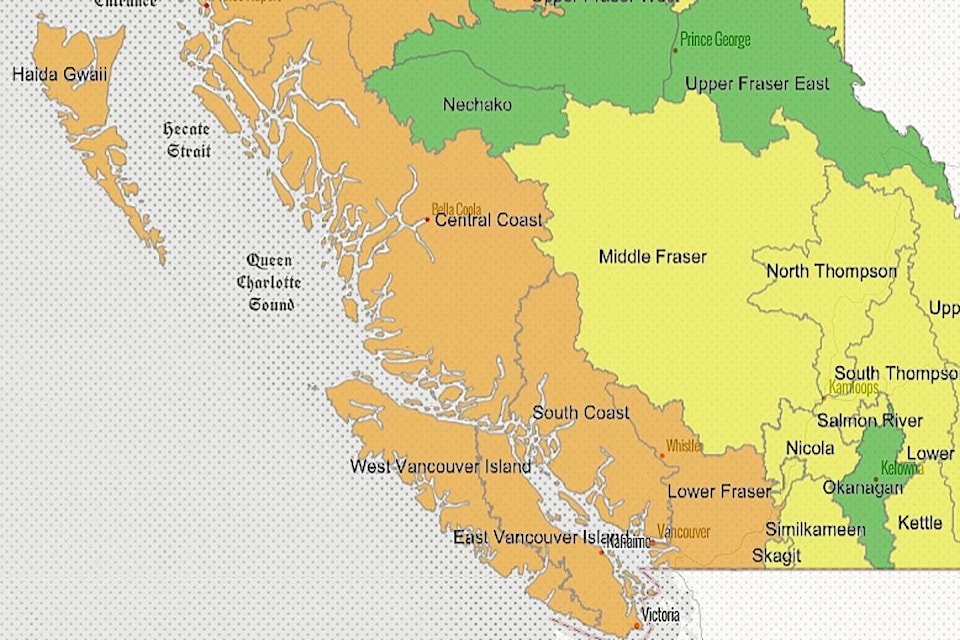The call for voluntary water conservation came in the haze of the recent heat wave.
Extremely warm and dry conditions prompted the Province of B.C. to announce a Level 3 hydrological drought rating for much of coastal B.C., including the Lower Mainland.
But even in Chilliwack where it has cooled down, some in the ag sector are saying it’s still important to always be mindful about conserving precious water resources.
Coun. Chris Kloot, chair of the Agricultural Advisory Committee, and a chicken farmer, said he is not sure if he would agree about the drought situation.
“While it certainly is dry and hot, typical of any July for the most part, I wouldn’t go as far to say we are in a drought,” Kloot said. “There was sufficient rain this past June and into early July, and one example is the corn crop for the most part is looking really good.”
Weather patterns are always changing, he said.
“We are fortunate to live in such a productive agricultural area of the province with access to adequate amounts of good water, but that being said it’s always good to be mindful of this precious resource and use good watering practices.”
In Chilliwack, UFV agriculture professor Tom Baumann, who also owns the Expert Agriculture Team consultant firm, agreed about not wasting water.
“As we again battle a heat wave and increasing water restrictions, we are getting used to dealing with it,” Baumann said. “We have plenty water to go around here at the usually wet coast, however, we must be careful not to waste our resources.
“Farmers have over the past 20 years done a remarkable job at controlling water use as a means to participate community wide to get through the drought conditions.”
Baumann said he noticed drought-like conditions have arrived later in the season than they did last summer.
“Here in the Fraser Valley we see some patches of corn that are starting to roll their leaves to conserve water and could turn brown and die well before harvest if this continues,” Baumann said. “In 2017 we came to that stage earlier, in 2018 we had rain longer in spring to replenish the soil.”
Baumann offered his take on how crops are impacted by drier-than-average conditions.
Berries don’t “size up” in a prolonged heat wave, he pointed out, and the harvest period doesn’t last long, which leads to labour shortages.
“Lucky for us, raspberries, strawberries were done before the heat started, the early varieties of blueberries are also picked already, but we still have August and September to go for blueberries, vegetables, corn and other field crops,” Baumann added.
“On top of that, after 1st of July plants are preparing flower buds for next year and if the drought is long, damage to next year’s crops may already occur as early as August. Workers get fatigued under heat conditions and especially between plant rows the heat can be stifling.”
The most drought-affected areas right now stretch along the coast from the Alaskan border down to the Lower Mainland, with some basins in the Northwest, like the Skeena and the Stikine.
In some parts of B.C. “irrigation scheduling,” is becoming the norm.
“Irrigation scheduling is now commonplace in agriculture,” Baumann said. “The most sophisticated systems actually can be turned on and off from a smart phone, and one can incorporate moisture sensors into the system to water to a certain level of moisture in the soil.”
Level 3 drought conditions call for voluntary water-use reductions from all surface-water and groundwater users, including municipal, agricultural and industrial users. Water licences could be suspended in extreme cases.
“If voluntary reductions of water use are not sufficient to maintain flows above critical levels, the ministry may consider regulating water usage under the Water Sustainability Act,” according to the provincial news release. Specific actions could include the temporary suspension of water licences or short-term water approvals to restore flows to minimum critical levels in the affected streams.
“Water users on all streams are reminded to ensure that water intakes are screened to the Department of Fisheries and Oceans standards to prevent fish from being pulled into water systems as water levels drop. Low water levels can impede the passage of salmon, increase susceptibility to disease, or cause stranding or death due to low oxygen and high water temperatures.”
Water conservation tips at home:
* limit outdoor watering
* do not water during the heat of the day or when it is windy
* consider planting drought-tolerant vegetation
* take shorter showers
* do not leave the tap running (i.e. while brushing teeth)
* install water-efficient showerheads, taps and toilets
On the farm:
• implement an irrigation scheduling program using real-time weather data
• schedule irrigation to match crop needs and soil storage capacity
• improve water system efficiencies and check for leaks
• focus on high-value crops and livestock
Industry:
• reduce non-essential water use
• recycle water used in industrial operations
• use water-efficient methods and equipment
@CHWKjourno
jfeinberg@theprogress.com
Like us on Facebook and follow us on Twitter.
